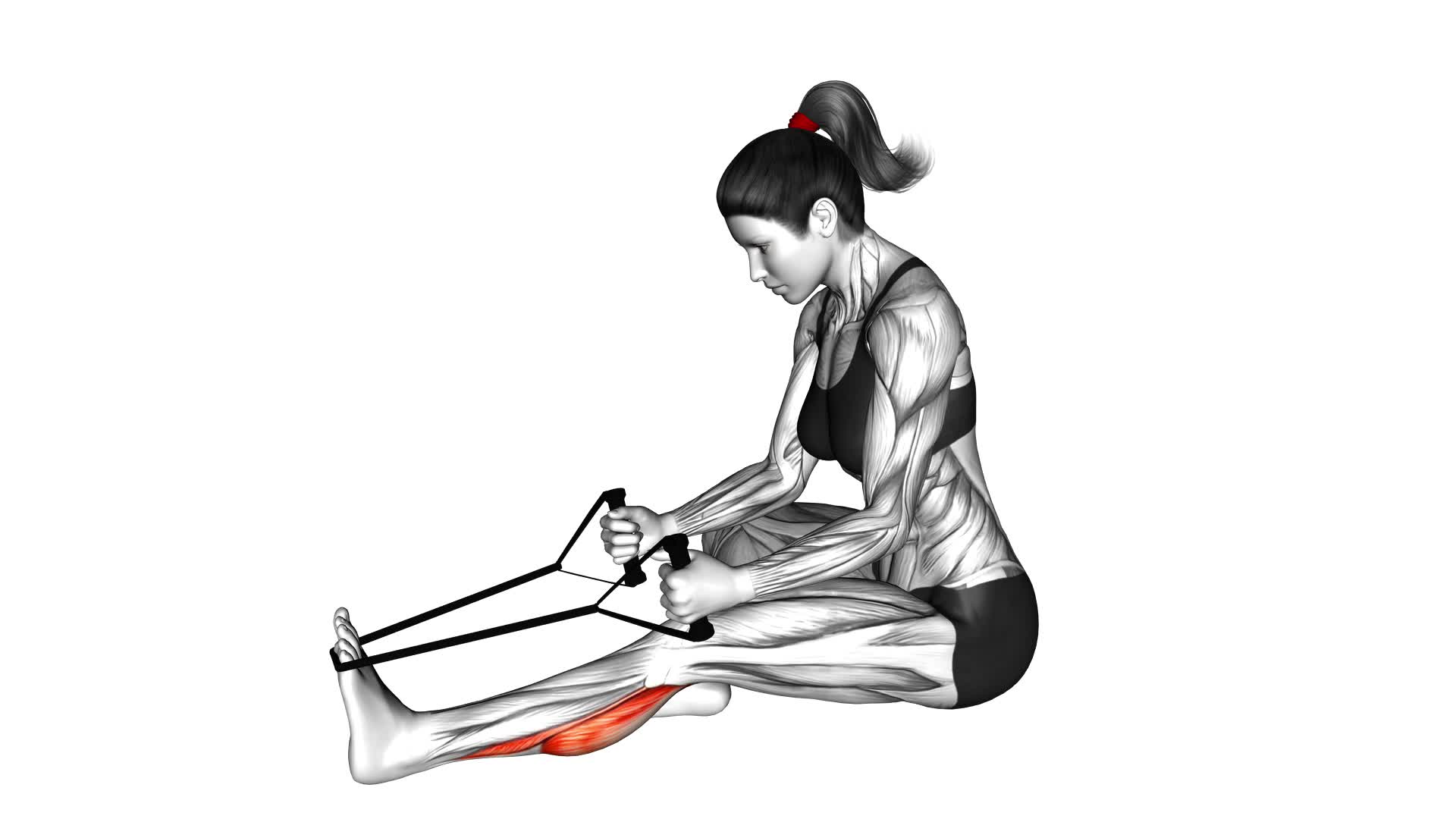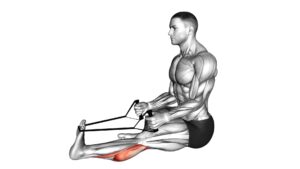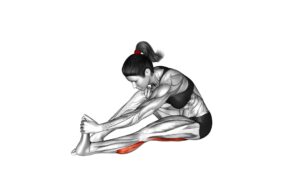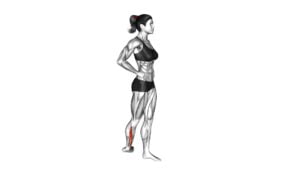Peroneals Stretch (female) – Video Exercise Guide & Tips

Are you a female looking to improve your flexibility and prevent injuries? Look no further than the Peroneals Stretch!
Watch This Exercise Video
This video exercise guide will show you the proper technique and variations for increased difficulty. Avoid common mistakes and get the most out of your stretch with our expert tips.
Discover the recommended frequency and duration for optimal results. Get ready to strengthen and lengthen your peroneal muscles with this informative and precise workout.
Let's get stretching!
Key Takeaways
- Peroneals stretch targets the peroneal muscles and improves flexibility, stability, and foot function.
- Proper form and technique are crucial for performing the peroneals stretch correctly.
- Flexibility plays a vital role in preventing injuries and enhancing athletic performance.
- Performing the peroneals stretch for at least 30 seconds per stretch, 2-3 times a day, can maximize its benefits and optimize progress.
Benefits of Peroneals Stretch for Females
Discover the numerous benefits that the Peroneals Stretch can provide for females. The Peroneals Stretch is a highly effective exercise that targets the peroneal muscles, which are located on the outer side of the lower leg. This stretch helps to improve flexibility, stability, and overall foot function.
Proper foot positioning is crucial when performing the Peroneals Stretch. Begin by standing with your feet hip-width apart. Place your left foot behind your right foot, keeping the toes pointed slightly outward. Shift your weight onto your left foot while bending your right knee slightly. This will create a stretch in the peroneal muscles of your left leg. Hold this position for 30 seconds, then switch sides and repeat.
To enhance the effectiveness of the Peroneals Stretch, consider using stretching accessories such as a foam roller or a resistance band. Using a foam roller can provide a deeper stretch and release tension in the peroneal muscles. A resistance band can be used to add resistance and challenge the muscles even further.
Incorporating the Peroneals Stretch into your regular exercise routine can help prevent injuries, improve balance, and increase ankle stability. By targeting the peroneal muscles, females can maintain strong and flexible feet, which are essential for various activities and sports.
Proper Technique for Peroneals Stretch
To properly perform the Peroneals Stretch, begin by standing with your feet hip-width apart. Follow these steps to ensure proper technique:
- Shift your weight onto your right foot while crossing your left leg over it.
- Bend your right knee slightly and keep your left leg straight.
- Place your right hand on a stable surface for support.
- Slowly lean your upper body towards your right foot, feeling a stretch along the outside of your left ankle.
- Hold the stretch for 20-30 seconds, focusing on deep breathing and relaxation.
- Repeat the stretch on the opposite side.
Stretching the peroneals muscles can provide several benefits. It helps improve flexibility, which is crucial for maintaining joint range of motion and preventing injuries. This stretch specifically targets the peroneals, which are important for ankle stability and balance. By stretching these muscles regularly, you can enhance your overall athletic performance and reduce the risk of sprains or strains.
Now that you have mastered the proper technique for the Peroneals Stretch, let's explore variations that can increase the difficulty of the exercise.
Variations of Peroneals Stretch for Increased Difficulty
To increase the difficulty of the Peroneals Stretch and challenge your muscles further, you can try incorporating variations into your routine. These variations are advanced techniques that can help take your stretch to the next level.
One variation you can try is the standing peroneals stretch. Instead of sitting on the ground, stand up and place the top of your foot against a wall or sturdy object. Lean forward gently to feel the stretch in your peroneal muscles.
Another variation is the towel peroneals stretch. Sit on the ground with your legs extended in front of you. Loop a towel or resistance band around the ball of your foot and gently pull it towards you, feeling the stretch in your peroneals.
Additionally, you can try the peroneals stretch with a partner. Sit on the ground with your legs extended and have your partner gently push your foot inward, increasing the stretch in your peroneal muscles.
These variations can help target your peroneal muscles in different ways, providing a more challenging workout for your lower legs.
Common Mistakes to Avoid During Peroneals Stretch
To ensure proper execution of the peroneals stretch, it's imperative to avoid common mistakes.
Firstly, incorrect foot positioning can hinder the effectiveness of the stretch. Make sure to align your foot properly to target the peroneal muscles.
Secondly, insufficient stretch duration can limit the benefits of the exercise. It's crucial to hold the stretch for an adequate amount of time to allow for proper muscle elongation.
Incorrect Foot Positioning
Avoid placing your feet in the incorrect position during the Peroneals Stretch to ensure proper form and maximize the benefits of the exercise. Proper foot alignment is crucial for maintaining ankle stability and preventing injury. Here are some common mistakes to avoid:
- Placing your feet too close together: This can limit the range of motion and reduce the effectiveness of the stretch.
- Turning your feet inward or outward: This can put unnecessary strain on the ankles and destabilize your stance.
- Allowing your arches to collapse: Maintaining a strong arch helps to stabilize the foot and ankle, preventing excessive pronation or supination.
Insufficient Stretch Duration
Make sure you give the peroneal muscles enough time to stretch properly, as insufficient stretch duration can hinder your progress and limit the benefits of the exercise. The benefits of longer stretch duration include increased flexibility, improved range of motion, and reduced risk of injury.
When you stretch a muscle, it gradually elongates and adapts to the new length. Consistent stretching is important because it helps maintain the gains made during previous stretching sessions. By stretching regularly, you can prevent the muscles from tightening up again and maintain the improved flexibility.
Aim for at least 30 seconds to one minute of stretching for each peroneal muscle group. Remember, taking the time to properly stretch will maximize the benefits and optimize your overall progress.
Tips for Getting the Most Out of Your Peroneals Stretch
To get the most out of your peroneals stretch, it's important to focus on proper form and technique. Ensure that you're maintaining a neutral spine and engaging your core throughout the stretch.
Additionally, pay attention to the duration and frequency of your stretches, aiming for at least 30 seconds per stretch and performing them 2-3 times a day for optimal results.
Proper Form and Technique
Achieving optimal results in your peroneals stretch relies on maintaining proper form and technique. To ensure you get the most out of your stretch, follow these tips:
- Stand with your feet shoulder-width apart and your knees slightly bent.
- Keep your back straight and engage your core muscles.
- Slowly lean forward from the ankles, while keeping your heels on the ground.
Maintaining proper form and technique during the peroneals stretch is crucial for reaping the benefits of stretching, such as increased blood flow, improved range of motion, and reduced muscle tension. Flexibility plays a vital role in preventing injuries and enhancing athletic performance. By stretching your peroneal muscles correctly, you can target and lengthen these muscles, improving their flexibility and overall function.
Now that you understand the importance of proper form and technique, let's move on to discussing the duration and frequency of the peroneals stretch.
Duration and Frequency
To maximize the benefits of your peroneals stretch, it's recommended to perform it for a duration of 30 seconds to 1 minute, at least 2-3 times per week. This recommended duration allows for adequate stretching of the peroneal muscles without overexertion or strain.
By holding the stretch for 30 seconds to 1 minute, you give your muscles enough time to lengthen and improve flexibility. Performing the stretch 2-3 times per week ensures that you're consistently working on maintaining and improving the flexibility of your peroneals.
This frequency allows for sufficient recovery time between sessions while still providing enough stimulus for progress. Remember, consistency is key when it comes to stretching, so aim to incorporate the peroneals stretch into your weekly routine for optimal results.
Recommended Frequency and Duration for Peroneals Stretch
For optimal results, perform the Peroneals Stretch at least three times a week for a duration of 30 seconds each time. This recommended frequency and duration will help you improve the flexibility and strength of your peroneal muscles, which are located on the outside of your lower leg.
Consistency is key in achieving the desired outcomes, so make sure to incorporate this stretch into your regular exercise routine.
Here are three reasons why following the recommended frequency and duration is important:
- Increased Flexibility: Performing the Peroneals Stretch three times a week allows for consistent elongation of the peroneal muscles. This will help improve the range of motion in your ankle and foot, making it easier to perform activities that involve ankle movements, such as walking, running, and jumping.
- Injury Prevention: Regularly stretching the peroneals can help reduce the risk of injuries such as ankle sprains. By improving the flexibility and strength of these muscles, you enhance the stability of your ankle joint, making it less prone to twists and sprains.
- Muscle Recovery: After intense physical activity or prolonged periods of sitting or standing, the peroneal muscles can become tight and fatigued. Performing the stretch three times a week allows these muscles to recover and regain their optimal length and function.
Frequently Asked Questions
Can Men Also Benefit From the Peroneals Stretch?
Yes, men can also benefit from the peroneals stretch. This stretch helps to improve the flexibility and strength of the peroneal muscles, which are located on the outer side of the lower leg.
By incorporating variations for men, such as using a resistance band or performing the stretch with a wider stance, it can further target and strengthen these muscles.
Regularly including the peroneals stretch in your routine can help prevent injuries and improve overall lower leg function.
How Long Does It Take to See Results From the Peroneals Stretch?
When it comes to the peroneals stretch, you might be wondering how long it takes to see results.
The effectiveness of this stretch can vary from person to person, so there isn't a set timeline for seeing results. However, with regular practice and proper form, you should start to notice improvements in flexibility and reduced tightness in your peroneal muscles over time.
Keep at it and be patient, as consistency is key for optimal results.
Can the Peroneals Stretch Help With Ankle Stability?
The peroneals stretch is an important exercise for improving ankle stability. Ankle stability plays a crucial role in sports performance, as it helps prevent injuries and enhances overall balance and control.
Incorporating ankle strengthening exercises, such as the peroneals stretch, into your routine can greatly benefit your ankle stability. By targeting the peroneal muscles, this stretch helps to strengthen and stabilize the ankle joint, allowing for better performance and reduced risk of injury.
Are There Any Precautions or Contraindications for Performing the Peroneals Stretch?
Before performing the peroneals stretch, it's important to be aware of any precautions or contraindications.
Precautions include avoiding this stretch if you have any recent ankle injuries or if you're experiencing severe pain or inflammation in the ankle.
Contraindications for the peroneals stretch include fractures or dislocations in the ankle, as well as any other conditions that may worsen with stretching.
It's always best to consult with a healthcare professional before attempting any new exercises.
Can the Peroneals Stretch Be Included in a Pre-Workout Warm-Up Routine?
The peroneals stretch can definitely be included in a pre-workout warm-up routine.
It helps to stretch and activate the peroneal muscles, which are important for ankle stability and balance.
However, if you're looking for alternatives, there are also other dynamic stretches that can target the same muscle group, such as ankle circles or heel walks.
Dynamic stretches have the added benefit of increasing blood flow and preparing your muscles for exercise.
Conclusion
In conclusion, the peroneals stretch is a beneficial exercise for females. It helps to improve flexibility and prevent injuries in the lower leg. By following the proper technique and incorporating variations for increased difficulty, you can effectively target and stretch the peroneal muscles.
Avoiding common mistakes and implementing the recommended frequency and duration will ensure optimal results. Remember to always listen to your body and consult with a professional if needed.

Author
Years ago, the spark of my life’s passion ignited in my mind the moment I stepped into the local gym for the first time. The inaugural bead of perspiration, the initial endeavor, the very first surge of endorphins, and a sense of pride that washed over me post-workout marked the beginning of my deep-seated interest in strength sports, fitness, and sports nutrition. This very curiosity blossomed rapidly into a profound fascination, propelling me to earn a Master’s degree in Physical Education from the Academy of Physical Education in Krakow, followed by a Sports Manager diploma from the Jagiellonian University. My journey of growth led me to gain more specialized qualifications, such as being a certified personal trainer with a focus on sports dietetics, a lifeguard, and an instructor for wellness and corrective gymnastics. Theoretical knowledge paired seamlessly with practical experience, reinforcing my belief that the transformation of individuals under my guidance was also a reflection of my personal growth. This belief holds true even today. Each day, I strive to push the boundaries and explore new realms. These realms gently elevate me to greater heights. The unique combination of passion for my field and the continuous quest for growth fuels my drive to break new ground.







